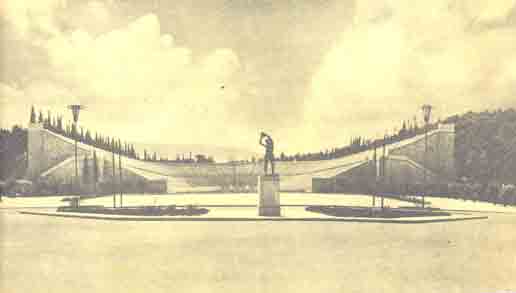Historical
Kallimarmaron Pan-Athenian Stadium
Kallimarmaron {Καλλιμάρμαρον} is the Greek compound word for "marble of great beauty" ({kalos ~ κάλλος} = great beauty + {marmaron ~ μάρμαρον} = marble).
The stadium was constructed in 330 B.C. by orator Lycourgos {Λυκούργος} and used to host great sporting events. With the passing of time the events were suspended and the stadium rendered useless. In 140 A.D., it was reconstructed by Herodes Atticus {Irodis o Attikos ~ Ηρώδης ο Αττικός} (101-177 A.D.). History repeated itself and with the passing of time it was covered by soil.
In 1869-1870, King Georgios I {Γεώργιος Α'} [People] called Hernest Tschiller {Ερνέστος Τσίλλερ} [The Thon Manor], a German architect, and asked him to unearth and reconstruct it. However, the stadium was restored in marble and regained its glory only after Georgios Averof {Γεώργιος Αβέρωφ}, a national benefactor, donated two million gold drachmas for this purpose.
In 1896, this majestic stadium hosted the first Modern Olympics [Contents] [500 Drachmas]. During these games, Spiridon Loyhs {Σπυρίδων Λούης} [People] ran fast and won the Marathon. Since then, the phrase "Egine Louis" {Έγινε Λούης} (that is "one flew off like Louis") became idiomatic in colloquial Greek and is used to describe somebody who runs like hell in order to avoid, or get away from something. It is interesting to note that five out of the first six Marathon Runners, were Greek.
The Kallimarmaron Pan-Athenian Stadium around 1964.

03-31-2004